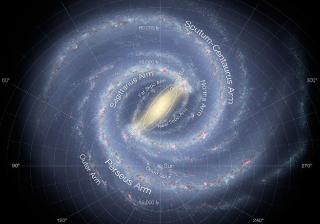Bibcode
Yaz Gökçe, E.; Karaali, S.; Duran, Ş.; Bilir, S.; Yalçınkaya, A.; Ak, S.; Ak, T.; López-Corredoira, M.; Cabrera-Lavers, A.
Referencia bibliográfica
Publications of the Astronomical Society of Australia, Volume 32, id.e012 9 pp.
Fecha de publicación:
4
2015
Número de citas
5
Número de citas referidas
5
Descripción
We estimated the scale-length of the thin disc with the J and W1
magnitudes of the most probable red clump stars in the Galactic plane, -
0°.5 ⩽ b ⩽ +0°.5, in 19 equal sized fields with
consecutive Galactic longitudes which cover the interval 90° ⩽ l
⩽ 270°. Our results are constrained with respect to the solar
space density (D* = 5.95), which indicates that the radial variation of
the density is lower for higher Galactocentric distances. The
scale-length of the thin disc is 2 kpc for the fields in the Galactic
anticentre direction or close to this direction, while it decreases
continuously in the second and third quadrants reaching to a lower limit
of h = 1.6 kpc at the Galactic longitudes l = 90° and l = 270°.
The distribution of the scale-length in 19 fields is consistent with the
predictions from the Galaxia model and its variation with longitude is
probably due to the inhomogeneity structure of the disc caused by the
accreted material or other features such as warp and flare.
Proyectos relacionados

Morfología y dinámica de la Vía Láctea
El Proyecto se estructura en dos partes, diferenciadas pero complementarias: morfología y dinámica. El estudio detallado de la morfología de la Vía Láctea pretende proveer una base de datos de distribución estelar en las regiones más alejadas y extintas de nuestra Galaxia, mediante el desarrollo de modelos semiempíricos a partir de la información
Martín
López Corredoira